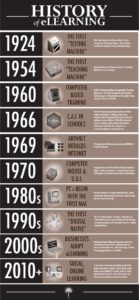
The development process of educational technology
Firstly, the development process of educational technology can be roughly divided into the following stages:
1. The budding stage—-the end of the 19th century
2. The initial stage—-the early 20th century to the 1920s
3. Stage of rapid development—-1930s to 1960s
4. Systematic development stage—-1960s to 1980s
5. Network development stage—–modern education technology (1990s to present)
In this long development process, there are many different kinds of educational tools have been used. The earliest educational technology can be traced back to the clay calligraphy and painting invented by the Sumerians in 3000 BC. The earliest education is through oral communication and writing. After the rapid development of modern science and technology, projectors and other intelligent electronic equipment appeared. Recent years, online learning has become the most popular existence in educational technology. We no longer learn from face to face, but use audio or video to establish communication and learning.

The earliest educational equipment appeared in 1924, and nowadays we can build open learning classrooms and use all the equipment that we needed for classrooms through the Internet. Open learning on the Internet provides a high degree of mobility and freedom for students, and students can also choose the way they like to learn. For example, in the process of learning professional knowledge, you can also gain skills and knowledge in different fields. However, even today when Internet information is super developed, the education platform built on the Internet is still very weak because there is no perfect solution to the coverage of network signal and the synchronization of teaching information. The following words appeared in the ppt of Sir John Daniel, O.C.:
- ACCESS (wider)
- QUALITY (higher)
- COST (lower)
He believes that there is a triangular relationship between the three of them. When the most stable state is reached among the three, network learning can be the most effective, save money and have the most audience. But it is difficult to achieve this equilibrium state.
Rreference:
Sutori. (n.d.). Retrieved October 25, 2020, from https://www.sutori.com/story/educational-technology-timeline–mNL3LPQAPeDbEQ7DNkpjdNGV
